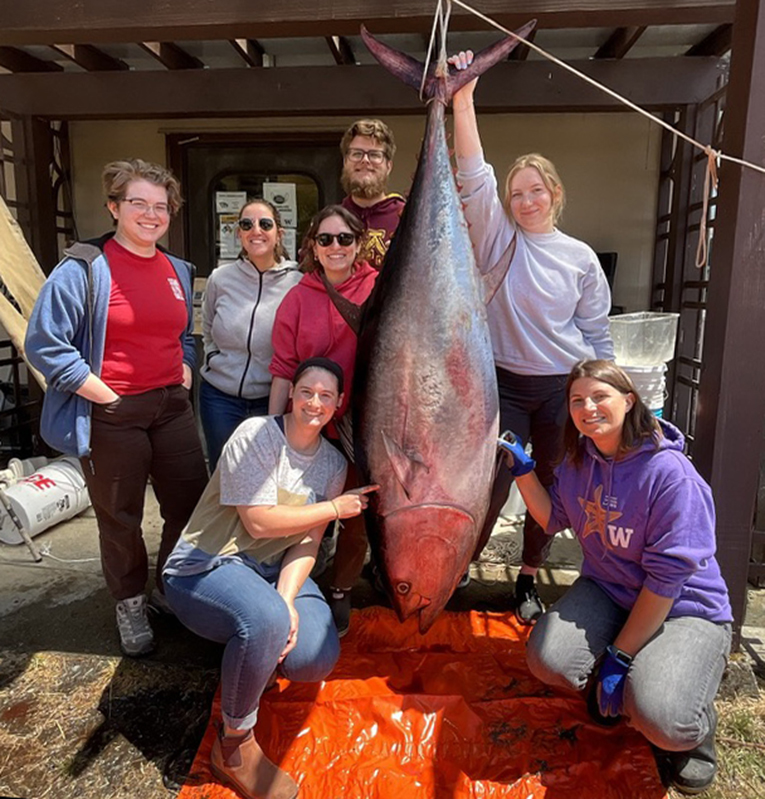Greetings,
Summer researchers at FHL carry with them a sense of purpose and urgency: in the time they are here (it’s never long enough), they are focused on gathering data to address a conceived scientific question. However occasionally during their stays, nature throws something unexpected at them, compelling them to lay aside their current projects to take advantage of the opportunity to study and learn from a chance circumstance. One such opportunity arrived this July in the form of a large tuna that washed ashore on Orcas Island. The animal was of particular interest to those working in FHL’s Comparative Vertebrate Biomechanics Lab (a.k.a. Lab 8), where research questions usually involve fish, their morphological structures, and how those structures function to allow the fish to succeed in their fishy lives. In this essay by Drs. Karly Cohen and Adam Summers, you can feel the excitement generated in Lab 8 by the arrival of a fish not only unknown to the Salish Sea, but also renowned for being one of the fastest in the world (along with other tuna species), thanks to unique morphological and physiological traits.
When Giants Roam Shallow Waters: A Rare Encounter With a Pacific Bluefin Tuna
by Karly E. Cohen & Adam P. Summers
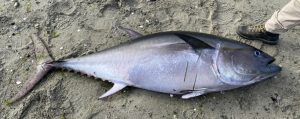
For centuries we have been fascinated by the natural history and migratory prowess of the Pacific bluefin tuna. One of the ocean’s top predators, the typical bluefin starts life as a 2 mm-long transparent larva, found in the nutrient-rich waters off Japan. The young fish mature into formidable giants: 1000 kg and 4 m long, swimming thousands of miles to reach feeding grounds in the western Pacific Ocean. The lunate, high aspect ratio tail is designed for high speed efficiency. It propels the fish to highway speeds, enabling them to hunt the fastest piscine prey with precision. The back half of their body is studded with finlets: small, strategically placed structures that shape flow for efficiency. The speed and size of tunas piqued the interest of bioengineers, who use them as models for underwater robotics and biomimetic design. Bluefin tuna are, in some regions of their body, warmer than the surrounding ocean. A rete mirabile – a complex network of arteries and veins – acts as a countercurrent heat exchanger. This allows them to retain heat in their core muscles, allowing them to thrive in colder nutrient-rich waters and maintain their remarkable swimming capabilities. Still, this internal warmth has its limitations and most bluefin on the U.S. west coast are not found far north of California. That is, until this summer, when the first Pacific bluefin tuna in the Salish Sea washed up on a gravel beach on Orcas Island.
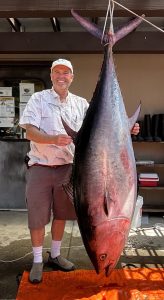
The day began with a text from Orcas Island resident and SeaDoc Society investigator Dr. Joe Gaydos. He wanted to know if a fish in an attached photo was an Albacore tuna. ‘Not if that is your foot’, was the consensus thought (Figure 1; click on images to enlarge). He asked if we wanted it, and the answer was an emphatic Yes! With help from Justin Cox of SeaDoc the fish was put on a stretcher, wrapped in orange tarps, and left at the Westsound public dock with an admonition that this was a fish for scientists. We swiftly assembled our team and made our way to retrieve the giant specimen in one of the Labs’ motorboats. Back on the FHL pier a growing crowd gathered to catch a glimpse of a fish that most of us had previously encountered only on sushi platters and in textbooks. Our first order of business was to measure the fish. First we determined that the fish was longer than most of the resident scientists, then we used a tape measure to determine it was 178 cm long. With pulleys and muscle power the fish was hoisted high in front of lab 8 and a load cell found its official weight, a whopping 214 pounds (Figure 2)! It would’ve weighed more like 275 pounds intact, except an enterprising Orcas resident cut out a full-length filet while the cadaver sat on the beach.
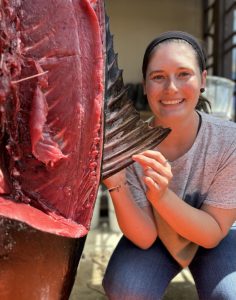
Dissecting a bluefin tuna was a “bucket list” event. Envision a bunch of enthusiastic anatomists leaning over, eagerly pulling on tendons, feeling and seeing the tail flex, the finlets pivot, and the dorsal fin retract into a faired opening in the back (Figure 3). We cut away the bulk of its body muscles, unveiling the intricate tendons that drive the sweep of the tail, and the smaller ones that dictate the positioning of its dorsal and pectoral fins. These fins are a marvel of nature’s engineering. They can fully retract into pockets, giving the tuna a sleek, torpedo-like shape for efficient propulsion. Progressing up the fish’s body, our attention turned to its colossal head: an armor-clad fortress. When you think of armor, you might envision knights in steel or the protective shells of turtles, but the realm of armored creatures extends far and wide and includes many fishes. The tuna’s densely mineralized, overlapping scales formed a formidable, flexible, gorget that protected the flesh behind it and above the gill covers. We removed the gill covering – an array of bones larger than your grandma’s serving platter – and took a closer look at the jaws. Much like other bony fishes, bluefin tunas sport hundreds of teeth – oral, palatal, and pharyngeal sets. Though numerous and sharp, these teeth weren’t sizeable, and more than a dozen were in the process of being replaced (Figure 4). We continued our exploration of the tuna’s anatomy, examining ovaries, stomach, liver, pyloric caecae and cloaca. The collected guts were carefully packaged and shipped off to various labs for in-depth analysis.
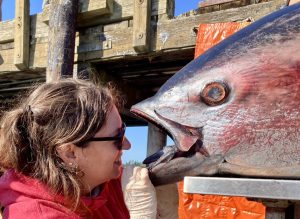
Throughout the dissection, one persistent question nagged on: how did this fish end up on Orcas? Bluefin tuna are found offshore of Washington by fishermen, a record that dates back hundreds of years and has a basis in Makah oral tradition. However, these records are all from the outer coast. This is the first time we know that a fish turned the corner at Cape Flattery and swam into the Salish Sea. Once here this fish, which may have come from a small school of 5-8 others, was in trouble. Tunas in general, and bluefin in particular, are ill suited to narrow, tide-swept rocky passages with dead-end bays that definitely don’t lead back to the open ocean. The evening before the stranding, kayakers in Eastsound saw a very large fish swimming rapidly from one side of the inlet to the other. As the tide receded the next morning the tuna was stranded in plain view of passers-by. It is unclear why the tuna landed in such shallow waters but the cadaver was fresh, the skin was clear with normal looking organs, and no gross injuries. The gills were loaded with gravel, and the gut was empty. Dr. Barabara Block of Hopkins Marine Lab speculated that this was an eight-year-old animal beginning the migration back to Japan to spawn. We will never know with certitude what killed this fish; maybe it got a bit too adventurous, ventured into a narrow fjord, and wound up stuck when the tide made a hasty retreat. Though the fish died, the specimen lives on at the Burke Museum, where the skeleton is part of the collection.
This tuna-tastic time was had by the following scientists: Karly Cohen, Stephanie Crofts, Cassandra Donatelli, Daniel Geldof, Olivia Hawkins, RC Hoover, Shirel Kahane-Rapport, Ferris Lee, Abel Lehman, John-Michael Racy, Max McKight, Max Schneider-White, Adam Summers and Meg Vandenberg.
